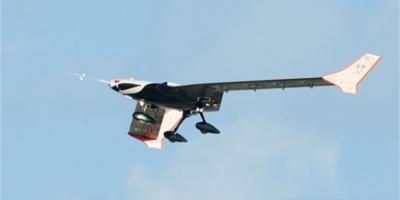Thu, Apr 17, 2014
Test Flights With A Flexible Wing To Be Conducted This Summer
The latest in a long series of experimental research aircraft, or X-planes, recently arrived at NASA's Armstrong Flight Research Center. Lockheed Martin, developer of the X-56A Multi-Utility Technology Testbed, is currently using the aircraft to explore technologies for active flutter suppression and gust load alleviation for the Air Force Research Laboratory's Multi-utility Aeroelastic Demonstration program.

The remotely piloted airplane had been housed at Edwards Air Force Base's North Base complex since last spring, where it was flown in a series of baseline tests involving a standard stiff wing. Pending resolution of scheduling and technical issues, the modular X-56A will be flown this summer with a flexible wing. Once these tests are concluded, the airplane and its ground control station will be transferred to NASA for follow-on research involving enabling technologies for new kinds of lightweight, energy-efficient, flexible aircraft.
According to NASA, the modular X-56A system includes two center bodies, a set of stiff wings, three sets of flexible wings, a ground control station, and a transportation trailer. The X-56A has easily removed wings and is convertible to other wing configurations, such as a joined-wing planform or a wing-tail configuration. The aircraft is equipped with a ballistic parachute recovery system, which is intended to recover the fuselage and the majority of the aircraft systems in the event of an inflight wing failure.

The initial flight tests of the X-56A system, performed by Lockheed and AFRL in the latter half of 2013 and extending into early 2014, collected flight data on highly flexible structures and flutter suppression control technology. Initially flown with a conventional stiff wing, the aircraft is subsequently being used to evaluate active flutter suppression with the flexible wings in early 2014. After these flights are completed, the X-56A will be transferred to NASA Armstrong to be used for research into lightweight structures and advanced control technologies for future efficient, environmentally friendly transport aircraft.
(Images provided by NASA)
More News
Aero Linx: Model Aeronautical Association of Australia MAAA clubs are about fun flying, camaraderie and community. For over 75 years, the MAAA has been Australia’s largest fl>[...]
Touchdown Zone Lighting Two rows of transverse light bars located symmetrically about the runway centerline normally at 100 foot intervals. The basic system extends 3,000 feet alon>[...]
“Discovery and innovation are central to our mission at Virgin Galactic. We’re excited to build on our successful record of facilitating scientific experiments in subor>[...]
How To Get A Story On Aero-TV News/Feature Programming How do I submit a story idea or lead to Aero-TV? If you would like to submit a story idea or lead, please contact Jim Campbel>[...]
Student Pilot Reported That During Rotation, “All Of A Sudden The Back Of The Plane Kicked To The Right..." Analysis: The student pilot reported that during rotation, “>[...]
 ANN's Daily Aero-Linx (05.02.24)
ANN's Daily Aero-Linx (05.02.24) ANN's Daily Aero-Term (05.02.24): Touchdown Zone Lighting
ANN's Daily Aero-Term (05.02.24): Touchdown Zone Lighting Aero-News: Quote of the Day (05.02.24)
Aero-News: Quote of the Day (05.02.24) ANN FAQ: Contributing To Aero-TV
ANN FAQ: Contributing To Aero-TV NTSB Final Report: Cirrus Design Corp SR20
NTSB Final Report: Cirrus Design Corp SR20




